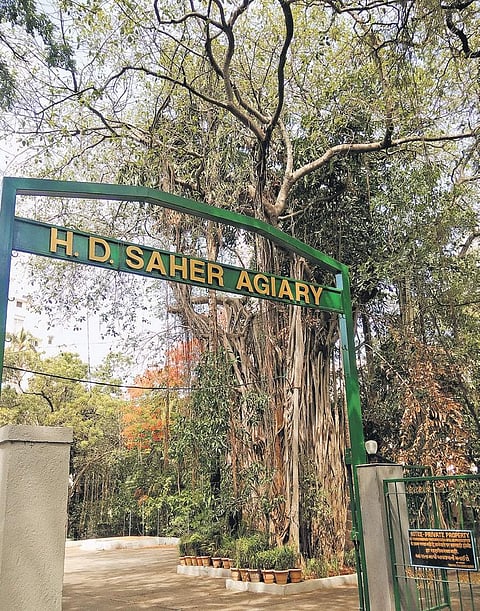

HYDERABAD: Tucked away in a quaint little lane in Breach Candy, Saher Agiary, a Parsi Fire Temple goes mostly unnoticed. But it came my way recently when I was exploring the quaint neighbourhood. The huge old trees in the charming little lane beckoned me to stop and stare, so I asked driver Krishna to drive up the lane to see what was in store. The centuries-old banyan tree housing hundreds of birds that chirped incessantly was like a warm welcome song for me. The adjacent old colonial bungalow framed by the pretty pink and magenta bougainvillaea creepers demanded a few minutes of admiration. That is when I noticed the board H.D. Saher Agiary.
Krishna hesitantly warned me that I would not be able to enter the fire temple, but still, I could try my luck. I assured him that I only wanted to get a feel of the place, got down, told him to park somewhere nearby and I would call him later.
Thus I ventured into the Saher Agiary compound, listening to the symphony of birds on the huge banyan tree, walking a bit cautiously and looking for some human presence. Soon I spotted a man dressed in white, with a white cap: he was the temple priest. I greeted him with a Namaste, folding both my hands and bowing deep and introducing myself as a journalist from Hyderabad and wanted to talk to him. He wasn’t overwhelmed by this prospect: looked at me a bit distrustfully but nodded reluctantly, opening the small gate. “But you can’t see the fire temple”, he said a bit sternly as a forewarning. I smiled and said, “No, I just want to talk to you”. He was visibly pleased with my preference: of choosing to interact with him over peeping into the temple. He led me to his living quarters, which was on the left: to my right was the sacred space of the temple, but I didn’t look that way even for a second, lest my intentions would be misconstrued.
As I stepped into the large verandah of his home, it was like entering a different world. A youngish woman in a headscarf was going about household chores; she gave me a faint smile more as a way of acknowledging my presence than welcoming. The old house with a tiled roof and mezzanine floor is filled with rosewood furniture and charming things of yore: a Planter’s chair that reminded me of my grandfather’s easy chair, where the wings open up and elders stretched their aching legs along them (in my childhood I would often climb into this chair when it was unoccupied, open the wings and try to put up my feet, imitating elders when they rested); a glistening rosewood dining table, teakwood cupboards some polished and others painted, laundry cabinet, a pot with tap, though amidst all this vintage wealth, a red plastic chair looked a bit incongruous.
Jal Katrak, the Dustoor and I sat down in this quiet place and chatted. By now he softened and was quite willing to answer my questions and even encouraged me to record the conversation.
“The fire temple is called dar-e-mehr in Persian and agiyari in Gujarati. As a Dustoor (a Zoroastrian priest) I don’t preach or hold sermons, but rather just tend to the fire. We offer prayers and sandalwood five times in a day to the sacred fire at Bombay time (which is 40 minutes behind and different from Indian standard time).” He described the layout of a temple since I can’t enter. “The large hall is where special ceremonies take place; the devotee enters a small anteroom; connected to this anteroom, or enclosed within it, but not visible from the hall, is the innermost sanctum the atashgah, literally ‘place of the fire’ in which the actual fire-altar stands. Only priests attached to a fire temple may enter the innermost sanctum. In one corner hangs a bell, which is rung five times a day at the boi ceremony, which marks the beginning of each gah, or ‘watch’. Though priesthood is hereditary, we have to study the scriptures and pass the exam to be qualified. My son (who just came in) also is a priest and helps me with the priestly chores. We are paid by the temple trust. From October to May people perform Navjot, weddings, receptions, functions etc. and thereby book the hall. The trust earns from letting out the hall and premises”, he said.
I heard the cawing of a few crows from the treetop. It was like music to my ears. (In Hyderabad crows have vanished long ago. Whenever I see a crow elsewhere, my heart fills with joy and I envy the locals who enjoy the presence of crows in their lives). When I asked, the priest said every day they feed birds and many flock the courtyard to feed. That is when I noticed a catapult hanging from the doorframe. “When there are too many of these crows creating a nuisance, I scare them with this sling … no, I never hit or harm them.” Jal Katrak was a different man by the time I left: friendly and smiling. He posed for pictures willingly, his son who chose to be in the background made some suggestions as I clicked pictures.
Before leaving I stood under the ancient Banyan tree for a few minutes listening to the birds and pondering over how the silent and solemn Saher Agiary reflects the peace-loving Parsi philosophy: that of private worship and public service.
(The author is a documentary filmmaker and travel writer; she blogs at vijayaprataptravelandbeyond.com)